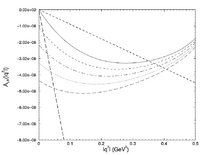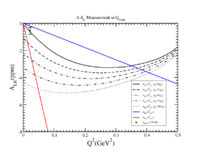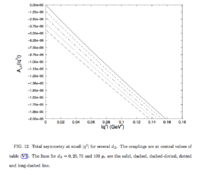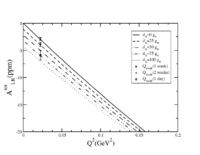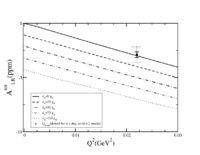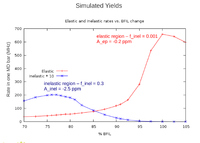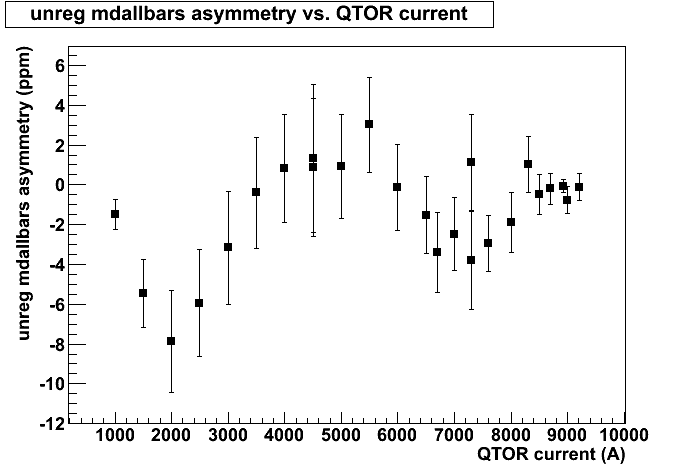Qweak Delta
Expected results
The above Figure in EPS format :File:D Delta Qweak Error.eps
File:A d-delta-vs-Q2.xmgrace.txt
The above Figure in EPS format :File:Atot d Delta Qweak Error.eps
File:Atot d-delta-vs-Q2.xmgrace.txt
Media:PCS_Report_4_LOI-03-105.pdf
Ratio of Elastic to Inelastic Region Rates = = 9.3:1 = Rate ratio for QTOR=100% / 75%
In the denominator 20 MHz = Inelastic rate and 50 MHz is the elastic rate; according to the simulation
Elastic Aluminum Asymetry
The Aluminum asymmetry was measured to be PPM
0.2 MHz/nA using warm gas target
Warm gas contribution about same size as downstream aluminum window.
To do aluminum measurement we can't use warm gas cell.
Aluminum window dilution 0.022+/- 0.002
Transverse Aluminum in Elastic
A sin wave with amplitude of about 4 PPM
You can weight the yields so the transverse asymmetry gets averaged over all octants.
File:Shi-Lin Zhu hep-ph-0107076 2001.pdf
first Inelastic Data
Asym -vs- QTOR
From Logbook entry https://qweak.jlab.org/elog/Analysis+%26+Simulation/254
The inelastic region of interest is expected to line up o the quartz bars when QTOR ~ 0.85 of its value for elastics.
In Feb 2011, QTOR(elastic) = 8921.
=> QTOR(Delta) = 0.85 \times 8921 = 7582
Run 9908
1 hour run with HWP OUT
https://hallcweb.jlab.org/hclog/1102_archive/110211010249.html https://hallcweb.jlab.org/hclog/1102_archive/110211020513.html
Run 9905
1 hour run with HWP IN
https://hallcweb.jlab.org/hclog/1102_archive/110210233842.html https://hallcweb.jlab.org/hclog/1102_archive/110211002416.html
Combining 2 hour of data taking
QTOR= 6700 Amps
I_{beam} = 145 \mu A
= Asymmetry averaged over all Main Detectors
If I assume only having 50 \mu A then I would need to take 6 hours of data to get the same statistic as above.
If I take a week of data at 50 \muA then that would correspond to 28 runs like the above.
So the uncertainty would be reduced by The measurement would have an uncertainty of 0.579/sqrt{28} = 0.1 PPM
background
Dave Mack's technical note on Qweak Background contributions and propogating their error. File:Qweak Doc 965 v1.pdf
Regression
https://qweak.jlab.org/wiki/index.php/Q-weak_Regression_Wiki_Page
Data Analysis
getting Qweak data from the Silo
jcache -g hallc /mss/hallc/qweak/rootfiles/pass0/*run number here*
looking for GOOD runs in database
There is a GUI interface on cdaql4 which can be run to look at run numbers and see their quality as recorded in the data base.
On cdaql4 run
./good_for_GUI
Root file format
The Qweak root files contain 2 trees ( MPS_Tree and EL_Tree). As the names suggest, the MPS tree contains data from devices for each Helicity bin. The HLS tree constructs helicity differences and asymmetries for each device in the data stream.
The devices listed in each tree above are folders which have sorted the data into 4 time windows within the helicity gate.
In the MPS_Tree there is a Bock0, Block1, Block2, Block3.
Drawing tree elements
Mps_Tree->Draw("qwk_bcm1.hw_sum","ErrorFlag==0")
If you get an error try
.ls
or try going up to the file subdirectory
if you pass the filename on the command line then the file is opened under the name file(0) so
_file0->cd()
should take you to the main subdirectory.
I think using the old TBrowser(0 screws up the pointers. "cd" to the file pointer when that happens.
